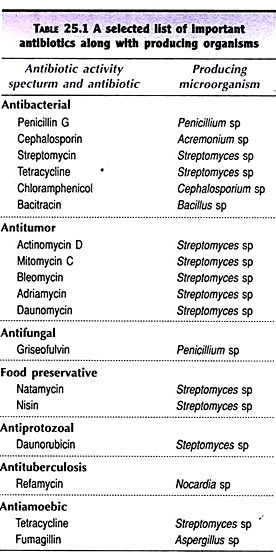Read this article to learn about the antibiotics and its production.
Antibiotics are the chemical substances that can kill microorganisms or inhibit their growth, and are therefore used to fight infections in humans or animals. Most of the antibiotics are produced by microorganisms (i.e. product of one organism that can kill other organism). Certain semi-synthetic antibiotics are the chemically modified natural antibiotics.
Antibiotics have undoubtedly changed the world we live in, and have certainly contributed to the increase in the human life-span. This is mainly due to the fact that several life-threatening infectious diseases could be conveniently cured by administration of antibiotics.
Antibiotics — General:
A brief history of antibiotics along with the microorganisms producing them, and their applications are given hereunder.
History of antibiotic discovery:
It was in 1928, Alexander Fleming made an accidental discovery that the fungus Penicillium notatum produced a compound (penicillin) that selectively killed a wide range of bacteria without adversely affecting the host cells. There are records that in some parts of Europe (in 1908) extracts of moldy bread were applied to wounds or abrasions to prevent infections, although the biochemical basis was not known. The penicillin discovery of Fleming has revolutionised antibiotic research.
Wide range of antibiotics:
Antibiotics are the most important class of pharmaceuticals produced by microbial biotechnological processes. They are the products of secondary metabolism. Around 10,000 different antibiotics are known, and 200-300 new ones are being added each year.
Most of these antibiotics are not of commercial importance due to various reasons—toxicity, ineffectiveness or high cost of production. There are around 50 antibiotics which are most widely used. In Table 25.1, a selected list of important antibiotics, their properties and the producing organisms is given.
They can control the growth of several unrelated organisms e.g. tetracycline’s, chloramphenicol.
Narrow spectrum antibiotics:
They are effective against selected species of bacteria e.g. penicillin, streptomycin.
Microorganisms producing antibiotics:
A great majority of antibiotics are produced by actinomycetes particularly of the genus Streptomyces e.g. tetracycline’s, actinomycin D. The bacteria other than actinomyces also produce certain antibiotics e.g. bacitracin. Among the fungi, the two groups Aspergillaceae and Moniliales are important for antibiotic production e.g. penicillin, cephalosporin, griseofulvin.
Production of Antibiotics — A Major Pharmaceutical Industry:
The commercial production of antibiotics is a highly profitable industry world over. Annual sales of antibiotics will run into several billions of dollars with an annual growth potential of about 10%. Antibiotics may be produced by microbial fermentation, or chemical synthesis, or a combination of both. For certain antibiotics, the basic molecule is produced by fermentation and its therapeutic value can be increased by chemical modifications.
The cost involved in production and chemical modifications, besides the efficacy of the antibiotic is very important in its manufacture. Biotechnologists continue their efforts to increase the fermentation yield and recovery processes to produce pure antibiotics.
